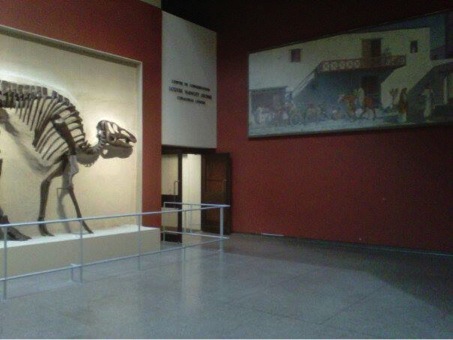In which Jess visits the Royal Ontario Museum and doesn’t get it .
Picture it: my bedroom at my aunt and uncle’s house, Saturday, 10:12 a.m. It was shaping up to be another in a growing line of cold, wet, depressing days. My continued exploration of Toronto would have to be confined to the indoors.
I decided to do what I’ve always liked to do when grappling with dreary conditions outside: go to the museum. The Royal Ontario Museum, to be exact. When I solicited opinions on this on Facebook, I got these:
“Waste of good money.” – Brigitte, former co-worker who lives just outside of Ottawa
“The ROM is awesome – go visit today!” – Jen, friend since high school who lives in Winnipeg
Intriguing. I had to see with which one of them I’d end up agreeing.
After you’ve visited the Manitoba Museum three or four times, you’ll likely have almost memorized it. It’s not very big, as far as museums go, and it’s easy to absorb; I’ll explain what I mean by that in a minute. But I always enjoyed visiting a couple of times a year. It might not have the name recognition of its nearest Toronto counterpart, but for what it is, it’s a good, solid museum.
Now let’s talk about the ROM. It’s big. It’s also confusing. The Manitoba Museum’s layout keeps you moving along a very deliberate path. At the ROM, you can start anywhere and end up anywhere. That may sound liberating, but it actually results in you wondering what the takeaway is supposed to be, besides “Here’s where we keep all the old things.” By contrast, the takeaway of the Manitoba Museum is “We’re going to teach you about how Manitoba has evolved.”
For example: Why was the gallery of ancient Chinese and Korean artifacts two floors down from the Greek, Roman and Egyptian antiquities? Why did the Natural History Galleries on the second floor interrupt the World Culture Galleries on the first and third floors? Why, as you can see in the above photo, were a skeleton of a hadrosaur and a painting called “Pompeii Scene” in the same otherwise empty corner? You wonder how much forethought went into the curation of this place.
“Hey, we just got another giant piece of amethyst. Where should we put it?”
“I dunno. I think there’s some room on the third floor.”
“You mean just outside the door to the Egyptian gallery?”
“Yeah, something like that.”
As for the exhibits themselves, they range in quality from amazing to meh. The Chinese and Korean collection is the amazing one, enough to be a museum unto itself, complete with a gorgeous replica of an entrance to an Imperial Palace. The Canada gallery, on the other hand, places so much emphasis on pre-Confederation furniture that you’ll think you left the museum and wandered into an antique store.
There’s also the fact that the Manitoba Museum’s exhibits are much more experiential. I spent the majority of my visit to the ROM looking at things in glass cases or on the wall. There weren’t many scenes to walk through – certainly no replica boats to board. The result is a sterile, joyless environment in which your assignment is to look at the cool stuff and get out.
And the stuff is cool. There was some amazing Aboriginal beadwork, and a beautiful ceramic model of a Chinese granary that made me think “They stored their grain in that? I’d live there.” But the stuff isn’t organized half as well as it could be.
Bottom line: Brigitte was right, especially considering admission to the main part of the ROM cost just a buck less than the cost of admission to two sections of the Manitoba Museum. It’s not going to be my cold-weather weekend escape. But I’m feeling more optimistic about Casa Loma.
[youtube url=”http://www.youtube.com/watch?v=RHmm-jbjtuY”]
__
Jess Chapman is a TV producer and freelance writer, recently transplanted from Winnipeg to Toronto, who has been known to act out the Monty Python “Spam” sketch with her younger brother in the mock-up diner in the Urban Gallery.
